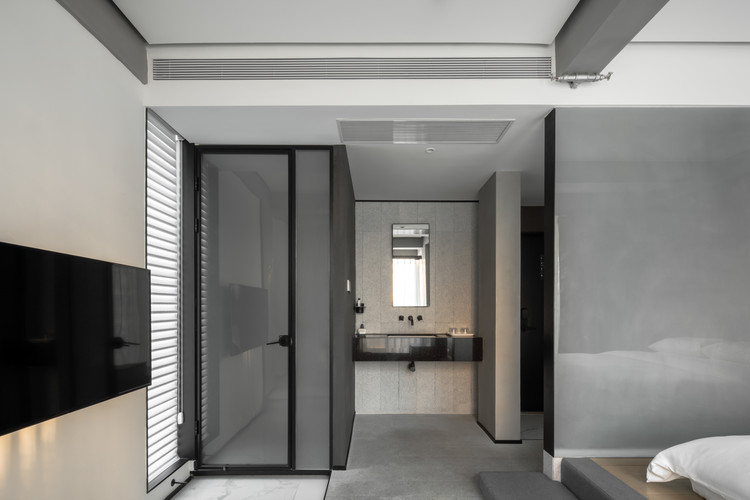
-
Architects: FZZF Studio
- Area: 900 m²
- Year: 2019
-
Photographs:Chuan He

Project Background. The overall renovation project of Fanzheng Restaurant and Tripsay Hotel is located in Yutian village, Shenzhen city which is at the intersection of modern prosperity and obsolescence. The new and old neighborhoods present the changes and connections of the city, bringing new propositions about urban renewal.

Overview. The building consists of seven floors, including the basement floor, Fanzheng restaurant on the first floor, and 16 guest rooms of Tripsay Hotel on the second to sixth floors. Based on the beam-column frame of the original building, Fanzheng architectural company realizes multiple functions within the boundaries of order and brings people a fresh and dynamic urban experience.

Daylighting. The open floor and a floor-to-ceiling glass of the building give people an intimate and spacious comfort. Appropriate lighting ensures the quality of the basic experience of the project. At the same time, to some extent, we also hope to retain the feeling of dark and deep as it is a village in the city, presenting the characteristics of the building itself and its harmonious relationship with the surrounding environment.


On the first to sixth floors, the bright and transparent window scenery and the grace of light and shadow are unreservedly packed into this space. On the basement floor, the dot-shaped lights create a lazy atmosphere. We use the light source to create two different atmospheres to realize the scene change for different emotions.

Spatial Structure. In a limited space, reduce the flow of public areas and maximize the area of the guest room. Strengthen the beam and column structure of the original building, and utilize this to showcase the division of spatial order and function.



Functional Area Division. Break the division of accommodation’s original functional areas and decentralize the functions in the guest rooms so as to maximize the use and experience of space. The shower, toilet, and washstand in the bathroom of the guest room have achieved a completely independent separation. It will be more convenient to use when crowds of people check-in and the dryness and cleanliness of the bathroom space is also guaranteed.

Spatial Hierarchy. Increase the vertical height difference level; the aisles and corner facilities lengthen the moving line. This design can reduce the disadvantages of limited space while simultaneously limiting the level of space and experience in a limited area.


Materials. We add the wood material to the exposed cement wall in order to create a cozy atmosphere as the latter is a little bit rustic and slightly rough. Picking out the right building material and suitable auxiliaries help present a comfortable and natural state. The formal decoration is removed, so that the material itself becomes a kind of landscaping, thus endowing the entire space with tension and recognition.

Nietzsche once said: “In architecture, people’s sense of pride, people’s gravitational success, and will to seek rights all show a visible shape.” We enter the bureau, we do not care about industrial upgrading but people’s connection and the recovery of the community. We hope that this project is not just a physical space, but an accessible field, which can become a place where people are willing to stay in this rushing society.




































